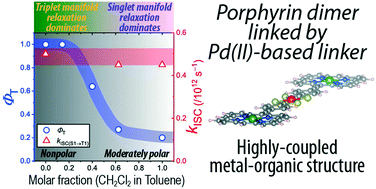当前位置:
X-MOL 学术
›
Mol. Syst. Des. Eng.
›
论文详情
Our official English website, www.x-mol.net, welcomes your
feedback! (Note: you will need to create a separate account there.)
Unusual solvent polarity dependent excitation relaxation dynamics of a bis[p-ethynyldithiobenzoato]Pd-linked bis[(porphinato)zinc] complex†
Molecular Systems Design & Engineering ( IF 3.2 ) Pub Date : 2018-01-29 00:00:00 , DOI: 10.1039/c8me00001h Jaehong Park 1, 2, 3, 4, 5 , Tae-Hong Park 6, 7, 8, 9, 10 , Louise E. Sinks 6, 7, 8, 9 , Pravas Deria 6, 6, 7, 8, 9 , Jiyong Park 6, 11, 12, 13, 14 , Mu-Hyun Baik 6, 11, 12, 13, 14 , Michael J. Therien 6, 9, 15, 16, 17
Molecular Systems Design & Engineering ( IF 3.2 ) Pub Date : 2018-01-29 00:00:00 , DOI: 10.1039/c8me00001h Jaehong Park 1, 2, 3, 4, 5 , Tae-Hong Park 6, 7, 8, 9, 10 , Louise E. Sinks 6, 7, 8, 9 , Pravas Deria 6, 6, 7, 8, 9 , Jiyong Park 6, 11, 12, 13, 14 , Mu-Hyun Baik 6, 11, 12, 13, 14 , Michael J. Therien 6, 9, 15, 16, 17
Affiliation

|
We report the synthesis and excited-state dynamics of a bis[p-ethynyldithiobenzoato]Pd(II)-bridged bis[(porphinato) zinc(II)] complex (PZn–Pd(edtb)2–PZn) that exhibits unusual solvent dielectric (ε)-dependent excited-state relaxation behavior. In nonpolar toluene solvent, PZn–Pd(edtb)2–PZn manifests an ultrafast S1 → T1 intersystem crossing time constant (τISC ≈ 2 ps), a broad, high-oscillator strength T1 → Tn transient absorption manifold (λmax(T1 → Tn) = 940 nm), and a near unity triplet-state formation quantum yield (ΦT ≈ 1; τT = 2.2 μs). In contrast, in moderately polar solvents (e.g., dichloromethane (DCM) or THF), the S1 → T1 intersystem crossing quantum yield is significantly suppressed (ΦT ≈ 0.2; τF ≈ 60 ps in DCM). Comparative femtosecond transient absorption studies in DCM and mixed DCM/toluene solvent systems reveal a new low-energy stimulated emission signal, the λmaxem of which is highly sensitive to solvent polarity. The lack of spectral signatures for radical species, and the emergence of intense stimulated emission indicate an additional low energy electronically excited-state (S*), populated via S1-state relaxation, that also possesses substantial singlet character. As solvent polarity is progressively increased, the energy of S* progressively decreases, eventually becoming lower than the S1 state and providing an excited-state relaxation channel that bypasses T1 state formation. These data show that the nature of the PZn–Pd(edtb)2–PZn excited-state dynamics is strongly influenced by the solvent dielectric, and that this Pd(II)-based linker motif offers new opportunities to engineer excited-state spin distributions and lifetimes in strongly conjugated chromophore assemblies.
中文翻译:

双[ p-乙炔基二硫代苯并呋喃] Pd连接的双[(卟啉)锌]配合物的不寻常的溶剂极性依赖性激发弛豫动力学†
我们报告了双[对-乙炔基二硫代苯并] Pd(II)桥联的双[(卟啉锌)锌(II)]络合物(PZn – Pd(edtb)2 – PZn)的合成和激发态动力学。(ε)依赖性激发态弛豫行为。在非极性溶剂甲苯,PZN -钯(EDTB)2 - PZN舱单超快小号1 →T的1系间窜跃的时间常数(τ ISC ≈2 PS),一个广泛的,高振荡器强度T 1 →T的Ñ瞬态吸收歧管(λ最大(T 1 →T的Ñ)= 940纳米),和近似统一的三重态形成量子产率(Φ Ť ≈1; τ Ť = 2.2微秒)。相反,在中等极性溶剂(例如,二氯甲烷(DCM)或THF)中,S 1点→T的1间跨越量子产率显著抑制(Φ Ť ≈0.2; τ ˚F ≈60个PS在DCM中)。在DCM中并混合DCM比较飞秒瞬态吸收研究/甲苯溶剂系统揭示了新的低能量的受激发射信号时,λ最大EM其中对溶剂极性高度敏感。自由基种类的光谱特征的缺乏,以及强烈的受激发射的出现表明通过S 1-态弛豫填充的另外的低能电子激发态(S *),其也具有基本的单重态特征。随着溶剂极性逐渐增加,S *的能量逐渐降低,最终变得低于S 1状态,并提供了一个绕过T 1状态形成的激发态弛豫通道。这些数据表明,PZn – Pd(edtb)2 – PZn的性质激发态动力学受溶剂电介质的强烈影响,并且这种基于Pd(II)的接头基序提供了新的机会来设计激发态自旋分布和强共轭生色团组装体的寿命。
更新日期:2018-01-29
中文翻译:

双[ p-乙炔基二硫代苯并呋喃] Pd连接的双[(卟啉)锌]配合物的不寻常的溶剂极性依赖性激发弛豫动力学†
我们报告了双[对-乙炔基二硫代苯并] Pd(II)桥联的双[(卟啉锌)锌(II)]络合物(PZn – Pd(edtb)2 – PZn)的合成和激发态动力学。(ε)依赖性激发态弛豫行为。在非极性溶剂甲苯,PZN -钯(EDTB)2 - PZN舱单超快小号1 →T的1系间窜跃的时间常数(τ ISC ≈2 PS),一个广泛的,高振荡器强度T 1 →T的Ñ瞬态吸收歧管(λ最大(T 1 →T的Ñ)= 940纳米),和近似统一的三重态形成量子产率(Φ Ť ≈1; τ Ť = 2.2微秒)。相反,在中等极性溶剂(例如,二氯甲烷(DCM)或THF)中,S 1点→T的1间跨越量子产率显著抑制(Φ Ť ≈0.2; τ ˚F ≈60个PS在DCM中)。在DCM中并混合DCM比较飞秒瞬态吸收研究/甲苯溶剂系统揭示了新的低能量的受激发射信号时,λ最大EM其中对溶剂极性高度敏感。自由基种类的光谱特征的缺乏,以及强烈的受激发射的出现表明通过S 1-态弛豫填充的另外的低能电子激发态(S *),其也具有基本的单重态特征。随着溶剂极性逐渐增加,S *的能量逐渐降低,最终变得低于S 1状态,并提供了一个绕过T 1状态形成的激发态弛豫通道。这些数据表明,PZn – Pd(edtb)2 – PZn的性质激发态动力学受溶剂电介质的强烈影响,并且这种基于Pd(II)的接头基序提供了新的机会来设计激发态自旋分布和强共轭生色团组装体的寿命。









































 京公网安备 11010802027423号
京公网安备 11010802027423号